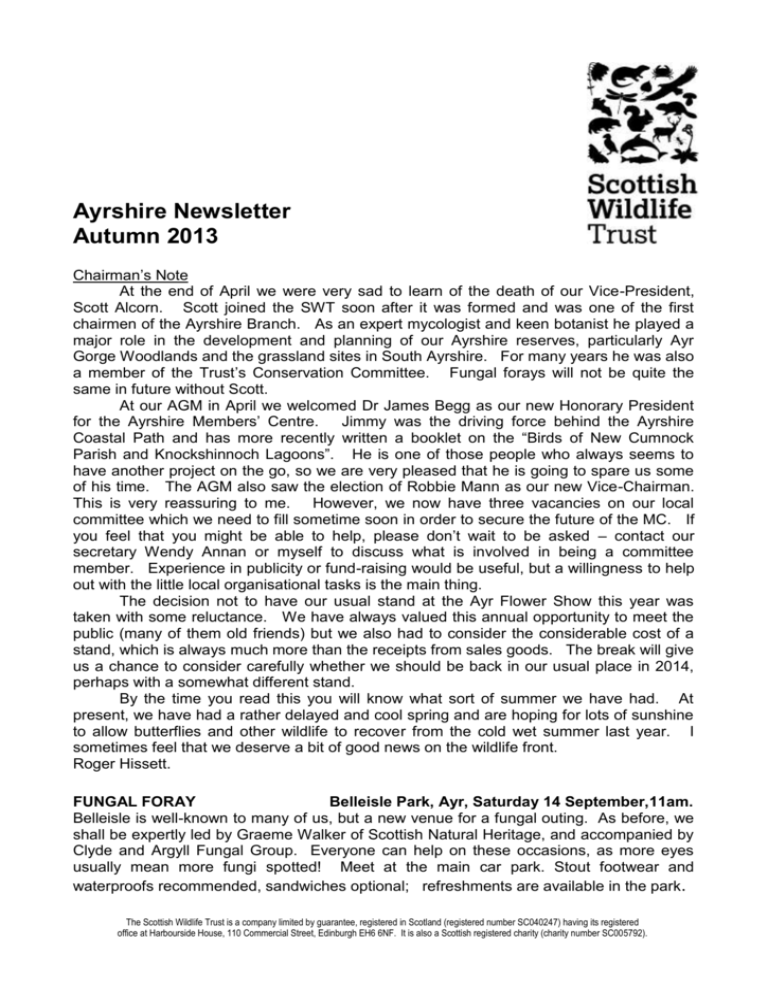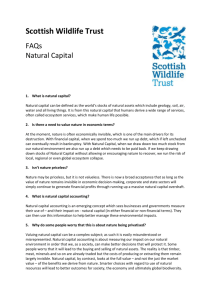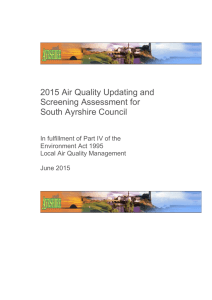Ayrshire Newsletter - Scottish Wildlife Trust
advertisement

Ayrshire Newsletter Autumn 2013 Chairman’s Note At the end of April we were very sad to learn of the death of our Vice-President, Scott Alcorn. Scott joined the SWT soon after it was formed and was one of the first chairmen of the Ayrshire Branch. As an expert mycologist and keen botanist he played a major role in the development and planning of our Ayrshire reserves, particularly Ayr Gorge Woodlands and the grassland sites in South Ayrshire. For many years he was also a member of the Trust’s Conservation Committee. Fungal forays will not be quite the same in future without Scott. At our AGM in April we welcomed Dr James Begg as our new Honorary President for the Ayrshire Members’ Centre. Jimmy was the driving force behind the Ayrshire Coastal Path and has more recently written a booklet on the “Birds of New Cumnock Parish and Knockshinnoch Lagoons”. He is one of those people who always seems to have another project on the go, so we are very pleased that he is going to spare us some of his time. The AGM also saw the election of Robbie Mann as our new Vice-Chairman. This is very reassuring to me. However, we now have three vacancies on our local committee which we need to fill sometime soon in order to secure the future of the MC. If you feel that you might be able to help, please don’t wait to be asked – contact our secretary Wendy Annan or myself to discuss what is involved in being a committee member. Experience in publicity or fund-raising would be useful, but a willingness to help out with the little local organisational tasks is the main thing. The decision not to have our usual stand at the Ayr Flower Show this year was taken with some reluctance. We have always valued this annual opportunity to meet the public (many of them old friends) but we also had to consider the considerable cost of a stand, which is always much more than the receipts from sales goods. The break will give us a chance to consider carefully whether we should be back in our usual place in 2014, perhaps with a somewhat different stand. By the time you read this you will know what sort of summer we have had. At present, we have had a rather delayed and cool spring and are hoping for lots of sunshine to allow butterflies and other wildlife to recover from the cold wet summer last year. I sometimes feel that we deserve a bit of good news on the wildlife front. Roger Hissett. FUNGAL FORAY Belleisle Park, Ayr, Saturday 14 September,11am. Belleisle is well-known to many of us, but a new venue for a fungal outing. As before, we shall be expertly led by Graeme Walker of Scottish Natural Heritage, and accompanied by Clyde and Argyll Fungal Group. Everyone can help on these occasions, as more eyes usually mean more fungi spotted! Meet at the main car park. Stout footwear and waterproofs recommended, sandwiches optional; refreshments are available in the park . The Scottish Wildlife Trust is a company limited by guarantee, registered in Scotland (registered number SC040247) having its registered office at Harbourside House, 110 Commercial Street, Edinburgh EH6 6NF. It is also a Scottish registered charity (charity number SC005792). EVENING MEETINGS PROGRAMME We shall again meet at 7.30pm on Tuesday evenings, in the comfortable premises of the Horizon Hotel, Esplanade, Ayr KA7 1DT. This provides plentiful parking, with all disabled facilities, and tea and coffee available in the interval. There is no charge for our meetings. 17th September –.Anton Watson: “Deer in and around towns.” Anton is a Wildlife Management Officer with Scottish Natural Heritage, working in lowland Scotland. He will be talking about the pleasures and problems resulting from growing urban deer populations. 15th October – Crinan Alexander: “Carrifran Wildwood, half-a-million trees further on.” The inspiring Carrifran project aims to recreate the original “wildwood” in a bare overgrazed Borders valley. Crinan has been involved with the project since the mid 90s and now chairs the Ecological Planning Group. The valley is being transformed . 19th November – Andrew Binnie: “Shore Rebels: COAST's fight for a healthier Clyde marine environment.” In its natural condition the Firth of Clyde held a profusion of sea life. The Community of Arran Seabed Trust is campaigning for a Marine Protected Area around the south of the island to augment the improvements already achieved by the No Take Zone in Whiting Bay. Andrew is a Marine Project Officer with COAST. There will be no meeting in December, but four more in 2014: 21st January – Bruce Philp: “ A fondness for beetles.” 18th February – Heinz Traut: “Conserving red squirrels – How you can make a difference” 18th March – Simon Jones: “Beaver update.” 15th April – AGM followed by “Wildlife Question Time”. BUTTERFLIES TRAVEL FROM COAST TO COAST The Scottish Wildlife Trust and Butterfly Conservation Scotland have teamed up to bring a beautiful and rare butterfly back to the Ayrshire coast. The Small Blue butterfly Cupido minimus was last seen in Irvine in 1983. Its extinction here is thought to have resulted from habitat destruction through development. The species is totally dependent on a plant known as kidney vetch to complete its life-cycle. After ensuring that the vetch is abundant, both in the Scottish Wildlife Trust’s Gailes Marsh Wildlife Reserve and neighbouring Dundonald Link Golf Course, thirty butterflies were collected from a monitored site on the Moray coast with a healthy Small Blue population. They were immediately brought south to be released the same day. Gill Smart, local Reserves Manager for the Scottish Wildlife Trust, said, “I had to drop everything and go when the sun came out. There had to be sunshine for the butterflies to be caught but we had to keep them cool once they had been. The whole method was pretty complicated. It was quite an emotional moment when I let them go and Small Blues were flying in Irvine for the first time in thirty years.” This project illustrates the need to prevent species dying out in the first place as bringing them back is not a simple matter. Both the Scottish Wildlife Trust and Butterfly Conservation are advocates of the landscape-scale approach to helping wildlife. This involves enlarging, improving and joining up areas of green space to create a connected network. Species have a better chance of survival if they can move across the landscape if things get tough for them where they are. The coastal habitats and golf courses in the south Irvine area are a good example of such a network. Scott Shanks of Butterfly Conservation stressed that moving species is a last resort and should only be done as part of a monitored study. He said “The most important element was getting the site ready to receive the butterflies. Local volunteers have been sowing and planting kidney vetch there for three years. They are delighted that the plants they nurtured so carefully could soon be getting munched by Small Blue butterfly caterpillars!”









